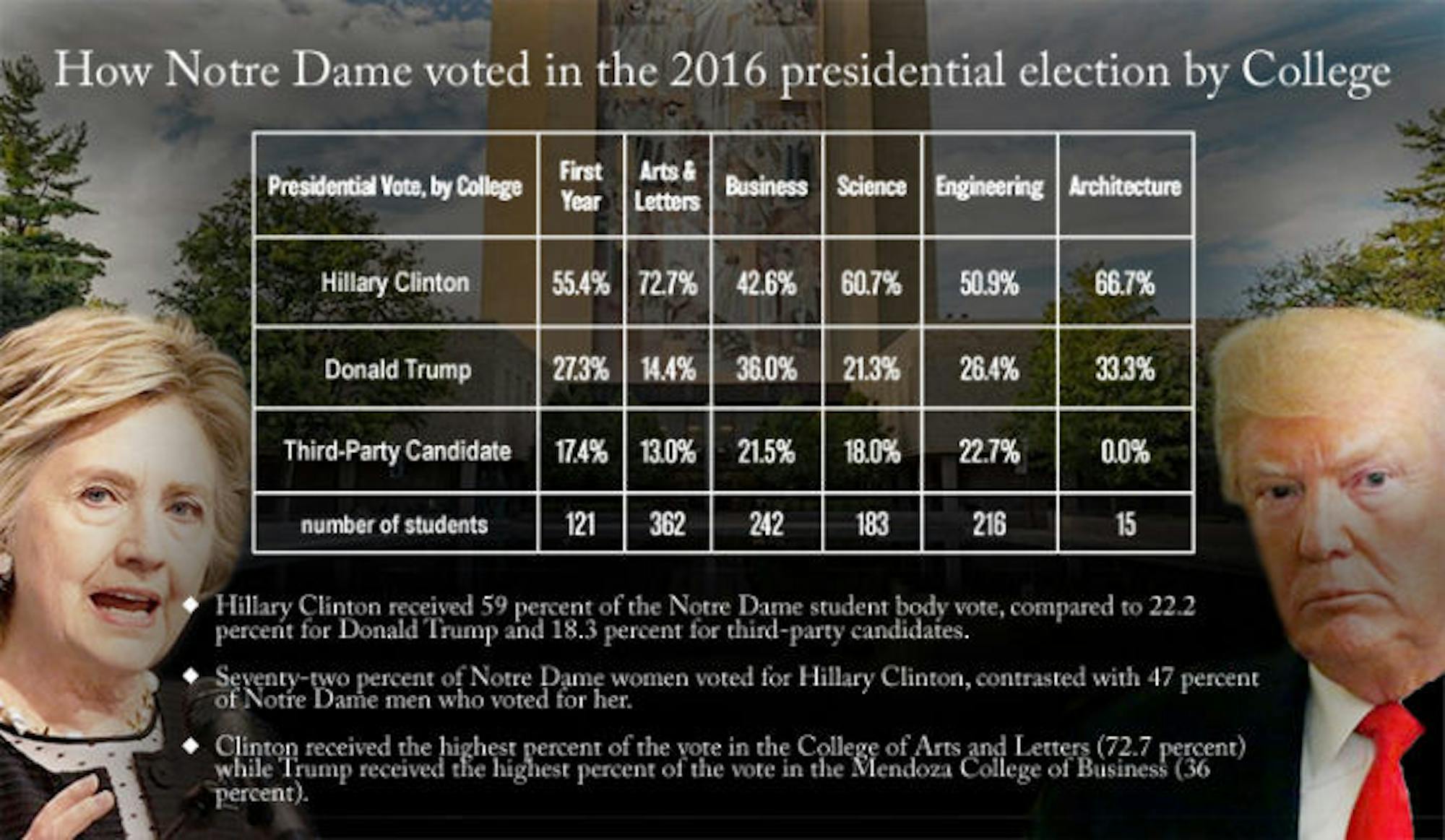Editor’s note: Throughout the 2018 midterm election season, The Observer will sit down with various student organizations and professors to discuss political engagement and issues particularly pertinent to students. In this third installment, the Center for Social Concerns discusses how Notre Dame students voted in the 2016 presidential election.
In the lead-up to the 2004 presidential election between then-President George W. Bush and John Kerry, Jay Brandenberger had an idea.
As the director of research and graduate student initiatives and academic community engagement at the Center for Social Concerns (CSC), Brandenberger said he believed Notre Dame did a good job allowing students to serve their communities. Even so, he had little idea how students engaged with their communities outside of this service.
“We knew very little at the time, [2003-2004], about how Notre Dame students vote,” Brandenberger said. “To my knowledge there weren’t any previous serious surveys. There’s always been election day stuff by the table in LaFortune … they might have 100 students, 200 students who stop by. … I wanted to have something that was more robust and rigorous and comprehensive.”
To explore this interest, Brandenberger said he decided to conduct a University-wide survey after the 2004 election of how Notre Dame students voted at all levels, surveying both graduate and undergraduate students.
Brandenberger said he was floored by the responses the first survey received.
“The numbers staggered me,” he said. “It was one of the first samples I’d done using an online tool, so I could sit in my office seeing the number of people who completed the survey and it went up by 100 in 10 minutes.”
As a result of the first survey’s success, Brandenberger and the CSC have conducted a similar survey the day after the presidential election every four years.
The results of the 2016 iteration of this survey were released Tuesday, in a report titled “How Notre Dame Voted: Political Attitudes and Engagement of Notre Dame Students in the 2016 Election.”
This year’s survey asked students to describe their preferences in three major subject areas — their vote, the issues they cared most about and where they got the news. The sample consisted of 2,956 randomly sampled undergraduate and graduate students, 61 percent of whom were undergraduates.
As a whole, Notre Dame voted for Democratic nominee Hillary Clinton, giving the former Secretary of State 59 percent of the vote versus 22.2 percent for President Donald Trump and 18.3 percent for third-party or write-in candidates.
Notre Dame women voted for Clinton at a much higher rate than men, with 72 percent of female voters choosing the Democratic nominee versus 47 percent of their male counterparts.
Clinton received the highest percent of the vote in the College of Arts and Letters (72.7 percent) while Trump received the highest percent of the vote in the Mendoza College of Business (36 percent).
Clinton and third-party voters were most likely to rank “political/ethical scandals” — a new issue added for this election — as the most important issue in determining their vote, while a plurality of Trump voters listed the economy as their most important issue.
For students who responded to the survey, the two most popular news sources were national print or online newspapers and social media.
Senior Aileen Markovitz, who wrote the first draft of the report, said the report was designed to be easily read and discussed.
“Our goal, our idea with the research was not to write an empirical paper — not something that would be published in a political science journal necessarily, but we wanted something that was really accessible to students,” she said.
Senior Katie Edler, who helped design the questions and edit the report, said a key finding of the survey was the shift toward third-party candidates.
“People that identified as conservative or Republican were a lot more likely to vote for third-party candidates than in the 2012 election,” she said.
Markovitz said Notre Dame’s unique identity might have contributed to this result.
“We believe … [this trend may be] due to Notre Dame’s Catholic character,” she said. “You have people who would not vote for Hillary Clinton because of ethical things — abortion — and people who wouldn’t vote for Trump for the same reasons. So we had a lot of write-in votes and third-party votes.”
For Markovitz, another key finding of the survey was that Notre Dame students were often insulated from people who had opposing beliefs.
“People would only feel very comfortable talking to their friends if they knew that they were of the same political belief system,” Markovitz said. “ … Notre Dame students are very polite and you don’t want to wake up on a Tuesday morning and have someone yelling at you about politics, it’s just not the character of the school, really.”
Brandenberger, Edler and Markovitz all said the project was not meant merely to describe the results of the 2016 election, but also to help start a conversation about politics on campus in the lead-up to the 2018 midterm elections and break students out of their political bubbles.
“It’s kind of easy to sit back in the classroom and point to trends and statistics, but this helps us understand, especially during a time of political divide,” Brandenberger said. “ … So this is a strategy to bring people together to hear one another.”
In anticipation of the upcoming midterm elections, the CSC has partnered with ND Votes to encourage political engagement.
“We are hoping [the partnership] will inspire more conversation around it, and more people registering to vote,” Edler said.
Brandenberger, Edler and Markovitz will be presenting their findings as part of the National Voter Registration Day Festival at Notre Dame on Monday at 5 p.m. in the Geddes Hall coffee house.













